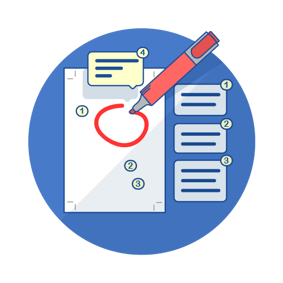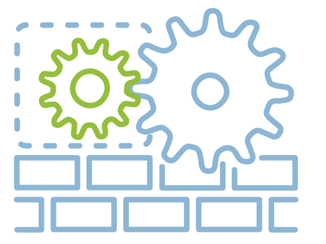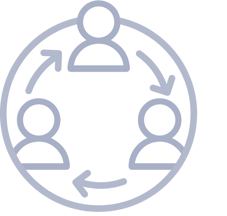Share this
How to Create and Optimize an Approval Process
by Sylvain Doré on March 17, 2022 10:58:00 AM EDT
Virtually all organizations involve at least one approval process in their day-to-day operations, from as 'simple' as submitting a daily report for review to presenting an annual strategy to be reviewed by the board of directors.
 Yet, it's no secret that approval processes can be the bane of efficiency, full of delays, endless revision cycles, and even disputes.
Yet, it's no secret that approval processes can be the bane of efficiency, full of delays, endless revision cycles, and even disputes.
Probably you've experienced the pain of submitting something for review, waiting for days until you've finally got feedback, only for the higher-ups or the clients to ask for another revision. Even worse, the inefficient time you've spent waiting for approval can often be as long or even longer than the time you've spent on the project.
The efficiency of the approval process will directly affect the organization's overall efficiency and productivity. Poor approval processes within a business process workflow will damage the business's overall performance, so the organization will need more time and resources to achieve its objectives.
In this guide, we will learn all you need to know about creating an effective and efficient approval process, and by the end of this guide, you'd have learned about:
-
What is a process? Process VS workflow
-
What is an approval process?
-
Key challenges to ensuring the efficiency of an approval process
-
Best practices for approval process efficiency
-
How you can streamline and optimize your approval workflows
What is a Process?
 All businesses and organizations always involve at least one process (or business process), and an approval process is just one example.
All businesses and organizations always involve at least one process (or business process), and an approval process is just one example.
So, what is a process?
The term "process" or "business process" is often used interchangeably with "workflow," creating confusion among those who don't know the difference between the two. Although they are deeply related, they are not the same.
We can define a "workflow" as a set of tasks or actions, typically sequential (one task must be completed before the next can be performed). When finished, it will achieve a specific business objective.
There are three different types of workflows based on predictability and repeatability, with process workflows being one of the three:
-
Process workflow: a process workflow (business process workflow) has predictable steps/tasks and is also repeatable. An approval process is the focus of this guide and is an example of process workflows.
-
Project workflow: a project workflow has predictable steps but is non-repeatable. When given the same input, a project workflow can produce different results. Handling a client's project is a typical example of project workflows in a graphic design agency.
-
Case workflow: a case workflow has unpredictable steps. The steps are initially unknown; only after more information has been gathered can we identify the steps needed to complete the workflow, which is also non-repeatable. Handing a customer complaint is an example of case workflows.
What is an Approval Process?
 As discussed, an approval process is an example of process workflows. In a nutshell, it is a process workflow in which one party attempts to obtain an opinion from another party to authorize an action, task, product, or a proposed result/outcome.
As discussed, an approval process is an example of process workflows. In a nutshell, it is a process workflow in which one party attempts to obtain an opinion from another party to authorize an action, task, product, or a proposed result/outcome.
In practice, the success and efficiency of an approval process require coordination between two or three main parties:
-
Submitter: the person presenting a deliverable (a document, proposal, product, application, etc.)
-
Internal approver: typically the higher-ups of the submitter, the person within the organization responsible for reviewing the deliverable and giving approvals.
-
External approver: not always available, depending on whether the approval process involves external parties (clients, vendors, sponsors, etc.)
However, ensuring effective collaboration between the three parties can be easier said than done. It's crucial to avoid the misconception that the approval process is a separate workflow that is solely needed to finish the organization's task or workflow. Instead, the approval process should be considered a crucial part of the organization's overall business process workflow.
While different approval processes can vary, all proper approval processes must include the following elements:
-
Deliverable: the item that needed to be approved by the approver. This can be a document, product, artwork, video, invoice, and so on.
-
Approver: the person responsible for deciding whether the submitted deliverable should be approved or not. An approval process may involve multiple approvers, so the approval process must also determine whether approvals/reviews should happen in sequence or in parallel between different approvers.
-
Timeline: the approval process must have set deadlines to ensure efficiency. A limitation on the number of revisions allowed may also be necessary.
-
Access control: if the approval process involves multiple approvers, it's crucial to establish different permission levels for each: who can approve/reject, who can make edits, who can sign-off the project, etc.
-
Audit trail: it's crucial to record every step of the approval process to maintain transparency and accountability of all parties involved in the process. A proper audit trail is essential in resolving conflicts and disputes, which are common in most approval processes.
It's worth noting that in some industries where clear audit trails are legal requirements, a complete record of the approval process must be maintained, including but not limited to a record of user comments/feedback, revision requests, versions of deliverables, and sign-offs. To do so, having a comprehensive workflow management software solution or business process management software system may be required.
How To Create a Standardized Approval Process
 A key aspect of ensuring an optimal and efficient approval process is to ensure standardization. A standardized approval workflow can streamline the whole process and significantly improve its efficiency by eliminating confusion from all parties involved in the process.
A key aspect of ensuring an optimal and efficient approval process is to ensure standardization. A standardized approval workflow can streamline the whole process and significantly improve its efficiency by eliminating confusion from all parties involved in the process.
The focus here is to create a reliable process that can easily be repeated in the subsequent approval process to ensure effective collaboration between all stakeholders involved.
A standardized and optimal approval process will:
-
Ensure all parties involved know exactly the steps required in each approval process. This will improve consistency and remove confusion and disputes between different parties.
-
Ensure accountability for everyone involved in the approval process. Every stakeholder can see the current progress of the approval workflow, and everyone understands exactly what their responsibilities are and when they are needed. This will ultimately result in fewer revision cycles and quicker approvals.
-
Enabling organizations to monitor and analyze the approval process so bottlenecks and inefficiencies can quickly be identified and fixed
In turn, a streamlined approval process can offer the following benefits for the organization:
-
Accelerate completion of project delivery
-
Reduce or even eliminate communication and collaboration delays throughout the approval process
-
Eliminate the time needed in tracking down approvers whether they've given their feedback/approval and/or updating team members on the current status
-
An optimal approval process for projects involving external stakeholders can help ensure the deliverable stays within the client's parameters and preferences—fewer risks of errors.
-
Reducing the time and effort needed tracking, managing, and sharing different versions and files of deliverables.
Consistent implementation of an optimal approval process can ultimately improve the organization's efficiency and productivity.
Key Challenges in Creating an Optimized Approval Process
In most organizations, approval processes only have two possible outcomes: approved or rejected. Yet, in practice, approval processes can be very dynamic, and there can be numerous possible paths between the deliverable submission and the actual approval/rejection.
A lot of dynamic challenges can also happen along the approval process, and here are some of the most important ones to consider:
Email-based approval is not efficient
Unfortunately, many businesses nowadays still rely on email communications in their workflows, including approval workflows. Yet, email is not an ideal communication tool in an approval process due to several reasons:
-
When the approval process involves multiple approvers/stakeholders, it can be challenging to control the stakeholders and when to include/exclude when they reply to emails. This can result in transparency and security issues.
-
When the approval process involves a significant number of revision cycles, it can be tough to track different versions of deliverable files in an email thread.
-
It's challenging to track who has opened an email but forgot to reply/leave feedback. Feedback and approvals can come too late, which can cause confusion.
-
Feedback via email may not be directly tied to the sent file/asset. So, it can be challenging to keep track of which feedback is tied to which version of the asset.
Tracing asset versions
As briefly discussed above, tracing different asset/file versions can be very challenging in a lengthy approval process.
An approver may falsely recognize an older asset and thus provide inappropriate feedback, confusing the submitter.
Implementing proper version control using a proper workflow management solution is crucial. Otherwise, the challenges in versioning can cause significant delays to the whole approval process.
For instance, Aproove keeps a comprehensive record of all feedback, replies, and attachments for different versions added to the project. As soon as a new asset version is added to the workflow, the older version is locked immediately from approvers.
Detached and decentralized solutions
An average team or department can now use more than ten different apps and solutions in today's digitally-transformed businesses. These solutions are often not natively integrated.
For example, a creative team may have a videographer using Final Cut Pro, a copywriter using Google Docs, and a graphic designer using Canva. These solutions are detached from each other, and without a centralized workflow management system, collaborations would be complex.
Each of the different team members needs to export their assets, and send the asset to other stakeholders. Arranging access to these files, can significantly slow down the process. Decentralization of solutions can also be challenging for approvers in communicating their feedback.
A common solution for this issue is implementing two separate systems in an approval process: one for tracking and managing tasks and deadlines and another for storing assets and controlling access. This can be counterproductive in the long run.
Challenging collaboration between internal and external approvers
 If the deliverable involves external approvers, then there's a potential disconnect between internal and external approvers.
If the deliverable involves external approvers, then there's a potential disconnect between internal and external approvers.
For instance, the agreed workflow might be for the deliverable to be approved by internal approvers first (i.e., marketing managers) before external approvers. Still, a client may enter the approval process too early, causing confusion between stakeholders.
It's crucial to have a centralized workflow management solution capable of facilitating a centralized dashboard where both internal and external approvers can communicate, clearly understand the current status of the approval process, and know what's expected from them.
Lack of transparency and accountability
Failure to ensure all parties involved in the approval process can track the project's current status in real-time can result in a lack of transparency.
As a result of this lack of transparency, submitters may spend too much time chasing approvals rather than developing the asset/deliverable.
It will be challenging to ensure an optimal approval process without accountability.
Creating and Optimizing a Standardized Approval Process: Step-By-Step
While approval processes can vary depending on various factors, below are the basic steps you can follow to building a standardized and optimized approval process for your organization:
Step 1: Designing an approval matrix
An approval matrix is, in a nutshell, a document listing the names (or roles) of approvers and the activities/assets/deliverables that would need to be approved throughout the approval process.
Thus, an important foundation here is identifying your internal and (if any) external approvers and clearly defining their roles and responsibilities. List your approvers and divide them based on their roles and level of influence. Identify and prioritize high-level approvers.
Also, identify who needs to be informed but doesn't need to review/approve each step of the process. Ensure the approval matrix is centralized (i.e., within workflow management software, business process management software or online proofing solution) to ensure everyone involved in the process can track the progress of the approval process.
In an ideal approval matrix, the higher the influence level of an approver/stakeholder, typically the fewer items/assets they'd need to approve. For example, a finance manager may need to approve all reimbursement forms first, but a CFO may need only to review a monthly or weekly report of reimbursements.
Keep in mind that the approval matrix is not a one-off thing but rather should be updated continuously to reflect the status of the approval process when a new team member is joining the team or vice versa when someone leaves your team.
Step 2: Define the stages of the approval process
The next crucial step is to define the stages of the marketing approval process.
If your project involves external approvers, then we'd recommend creating separate documents for your internal and external review stages. This is especially important for lengthy approval processes so that you can optimize each of these processes separately.
When defining and documenting the different stages of the approval workflow, here are some essential considerations to have:
-
The focus is to efficiently design the approval stages to ensure everyone involved in the process can stay productive and minimize bottlenecks.
-
Define what types of assets or content should be segmented.
-
Identify which element(s) or detail(s) should be approved quickly for each asset.
If your process involves external approvers, identify which assets should be reviewed only internally, only externally, or both. -
The primary purpose of this step is to ensure approvers can receive deliverables as early as possible so you can ensure the project stays within the deadline.
A good approach is to interview or survey the stakeholders involved in the previous approval processes so you can gain more insights into how the workflow is currently executed and how it should be improved.
Step 3: Implementing access control
This step is critical when your approval process involves many different approvers and submitters (both internal and external approvers). Clearly defining who can access the asset and leave their feedback at each stage is crucial in preventing disputes and conflicting opinions.
Disputes can significantly slow down the approval process, so you'd want to reduce or even eliminate the risks of conflicts as much as you can.
You should only include a potential approver when their feedback is absolutely needed as a general rule of thumb. On each review stage of the approval process, define which approver(s) is required at each step while considering:
-
Qualification: how are they qualified for reviewing and approving certain aspects of the process.
-
Motivation: are they willing to provide feedback and approval at the time needed by the project's timeline?
-
Availability: are they available at the time needed by the project's deadline/timeline.
-
Creativity: whether this approver has the potential of giving unique insights into how the project's deliverable can be improved.
Remember that more approvers involved will translate to more risks of conflicting opinions and more revision cycles. Whenever possible, limit to only one approver per review stage.
Step 4: Mapping the approval process
Now that you've collected enough information about the approval process, the next step is to create a visual representation of the workflow in the form of a workflow diagram.
You can use various tools and techniques to map the approval process; the most basic and common method is using the ANSI flowchart to create a workflow diagram. If you've already incorporated a workflow automation solution like Aproove to manage your Approval Process, then you can use the solution's built-in workflow builder to create your workflow diagram.
The focus here is to create the workflow diagram as is, which means how the approval process is currently executed rather than how you'd like the process to be executed. Focus on accuracy.
Use the information you have collected in the previous steps: define each review stage and identify the approvers for each stage. Refer back to the approval matrix you've created.
Also, include clear instructions for approvers on the details:
-
What they should give feedback on
-
How to give their feedback.
-
When you need the feedback/approval to be given.
Don't let a lack of information slow down the approval process and communicate your deadline clearly.
The more complete and accurate your workflow diagram is, the easier your job in the next steps will be. So, take your time to polish and fine-tune the workflow diagram to ensure it is as accurate as possible.
Step 5: Optimizing the approval workflow
Once you've got an accurate workflow diagram of the approval process, you can analyze the workflow diagram to identify bottlenecks and figure out areas that can be improved in the workflow.
The main purpose of optimizing the approval process is to minimize revision cycles and ensure approval happens as quickly as possible without sacrificing the quality of the deliverable and its compliance with the project's requirements.
Specific to optimizing an approval process, an important consideration is minimizing the number of revision cycles to not more than two in every review stage: one for allowing the submitter to revise the deliverable according to the approver's feedback, and another for the approver's feedback approval/signing off.
Lowering the total number of possible revision cycles can be very effective in encouraging approvers to make the most of their feedback every time.
Step 6: Ensuring a comprehensive audit trail
Once your approval process has been optimized, the last (but not least) step is to ensure a clear update trail of the approval process. Depending on your organization's industry, keeping a comprehensive record of the approval process may also be a legal requirement.
Store all reviewed and approved assets in a centralized hub (i.e., a workflow management software solution) that is also searchable, so it's easy to find and use any previous assets whenever needed.
Also worth considering is establishing clear policies and templates for complex deliverables and challenging file formats (i.e., design files or video files). This is to ensure no details will be missed in keeping an audit trail.
Conclusion
Having a standardized, optimal, and efficient approval process is crucial in improving your business's productivity and efficiency. By implementing more control and optimization over the approval steps, you can save much back and forth during the whole process, which can improve consistency and collaboration among all the different parties involved in the process.
If you want to improve your marketing approval process with modern workflow management and an online proofing system, get started with Aproove today.
Share this
- Project Management (38)
- Featured (27)
- Online Proofing (27)
- Educational (25)
- New Release (25)
- Work Management (25)
- Business Workflow (23)
- Marketing management (22)
- Workflow Management (22)
- BPM Software (19)
- Marketing Workflow (19)
- Newsletter (19)
- Business Automation (17)
- Workflow Automation (16)
- Marketing Automation (14)
- enterprise project management (9)
- Task Management (7)
- business process workflow (7)
- BPM (6)
- Digital Asset Management (6)
- News (6)
- Aproove news (5)
- Industry News (4)
- insurance marketing (4)
- insurance work management (4)
- marketing process (4)
- team (4)
- Compliance (3)
- Retail Marketing (3)
- enterprise workflow management (3)
- AI (2)
- Document Management Automation (2)
- IT Project Management (2)
- Marketing Agency (2)
- Product Development (2)
- business process automation (2)
- creative workflow (2)
- printing workflow (2)
- Case Studies (1)
- Case Study (1)
- DAM Software (1)
- Document Workflow Automation (1)
- HIPPA (1)
- Healthcare (1)
- ISO (1)
- Insider (1)
- Resource Management (1)
- SOC2 (1)
- SaaS (1)
- brands (1)
- marketing teams (1)
- print (1)
- security (1)
- workflow diagram (1)
- workflow optimization (1)
- workflow process mapping (1)
- workflow software (1)
- March 2025 (11)
- February 2025 (10)
- January 2025 (10)
- December 2024 (9)
- November 2024 (10)
- October 2024 (5)
- September 2024 (8)
- August 2024 (10)
- July 2024 (9)
- June 2024 (11)
- May 2024 (6)
- April 2024 (7)
- March 2024 (7)
- February 2024 (6)
- January 2024 (4)
- December 2023 (3)
- November 2023 (7)
- October 2023 (7)
- September 2023 (3)
- August 2023 (5)
- July 2023 (3)
- June 2023 (1)
- May 2023 (1)
- April 2023 (1)
- February 2023 (2)
- September 2022 (3)
- August 2022 (1)
- July 2022 (1)
- May 2022 (1)
- March 2022 (3)
- February 2022 (3)
- January 2022 (3)
- November 2021 (2)
- October 2021 (2)
- September 2021 (1)
- August 2021 (4)
- July 2021 (4)
- June 2021 (2)
- May 2021 (3)
- April 2021 (1)
- February 2021 (1)
- November 2020 (1)
- October 2020 (2)
- July 2020 (4)
- June 2020 (2)
- May 2020 (2)
No Comments Yet
Let us know what you think